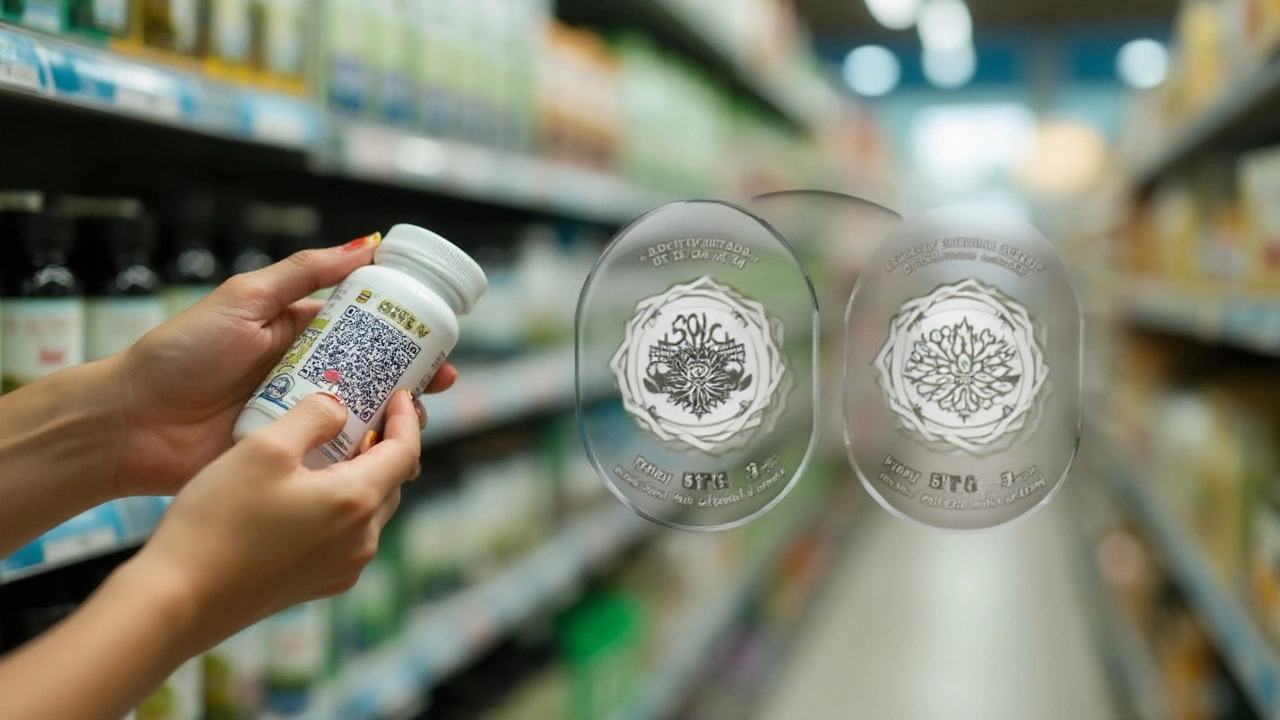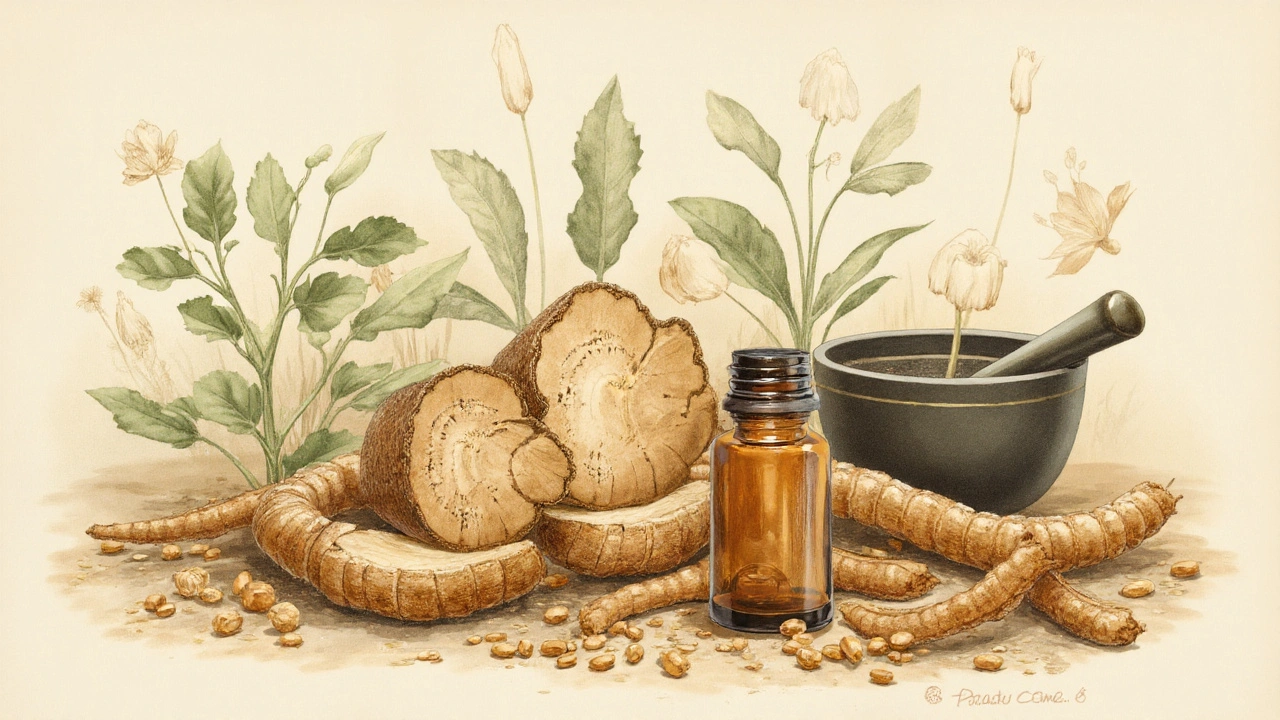Here’s the twist: there’s no single “secret” to optimal health. It comes from sleep, movement, nutrition, and stress control. But if you’re curious about Costus and wondering if it can earn a spot in your routine, you want the truth: what it is, what it might do, where the evidence stops, and how to use it safely.
TL;DR:
- “Costus” usually means Saussurea costus (also called costus root). It contains costunolide and dehydrocostus lactone, studied for digestive and anti-inflammatory effects.
- Human evidence is limited; most data come from lab and animal studies. Expect gentle support, not miracles.
- Typical doses: 500-1,000 mg root powder 1-2x daily, or 100-300 mg standardized extract 1-2x daily. Start low. Stop if you react.
- Safety first: avoid in pregnancy/breastfeeding, if you have ragweed allergy, or if you’re on anticoagulants without medical clearance.
- Buy smart: pick third-party tested, species-verified, sustainably sourced products; avoid essential oil ingestion.
Jobs you probably want to get done right now:
- Figure out what “Costus” actually is and which plant people mean.
- See if the potential benefits match your goals (digestion, inflammation, respiratory support).
- Know how to dose it and use it safely with your current meds and health status.
- Pick a high-quality product without contamination or fake labeling.
- Have a quick checklist and plan for what to do if something feels off.
What “Costus” Are We Talking About?
Supplement labels can be messy. When you see “Costus,” it most often refers to Saussurea costus (syn. Aucklandia lappa; older texts say Saussurea lappa). This is a Himalayan root used in Ayurveda and Unani medicine. It’s not the same as Costus igneus (“insulin plant”) or Costus speciosus (crepe ginger), which are different species with different chemistry and traditions. Always check the Latin name on the label.
Why the fuss about Saussurea costus? Its root contains sesquiterpene lactones-mainly costunolide and dehydrocostus lactone-plus essential oils, inulin-type fibers, and other compounds. In lab and animal studies, these molecules show anti-inflammatory, antimicrobial, and gastroprotective actions.
Two important notes before we go further:
- Conservation status: Saussurea costus is listed under CITES (Convention on International Trade in Endangered Species) due to overharvest. Responsible brands use cultivated sources or verified sustainable supply chains. This matters for both ethics and product quality.
- Evidence quality: Most of the “wow” is preclinical. Human trials are small, often use multi-herb formulas, and don’t isolate Costus alone. Treat the claims as “promising but not proven.”
Credible references include WHO Monographs on Selected Medicinal Plants (Saussurea costus profile), reviews in Phytotherapy Research and Journal of Ethnopharmacology, and safety data on sesquiterpene lactones in Frontiers in Pharmacology.
Potential Benefits: What It Can (and Can’t) Do
Set expectations: if a supplement’s benefits sound like a cure-all, they usually aren’t. Here’s what Costus shows in research-and where things are still cloudy.
- Digestive comfort (dyspepsia, gas, cramping): Animal studies and traditional use suggest antispasmodic and carminative effects. Some small human studies and polyherbal trials report symptom relief, but because multiple herbs were used, you can’t credit Costus alone. Think of it as a possible nudge, not a reset.
- Anti-inflammatory support: Costunolide and dehydrocostus lactone downregulate NF-κB and other inflammatory pathways in vitro. Animal models show reduced edema and inflammatory markers. Human confirmation is limited.
- Antimicrobial activity: Extracts and essential oil fractions inhibit several microbes in lab studies, including some gut and skin pathogens. This doesn’t mean it can replace antibiotics; it suggests a potential role in broader gut or skin-support strategies.
- Respiratory comfort: Traditional use includes cough and mild asthma support. Mechanistic data show bronchodilatory and anti-inflammatory signals in preclinical work. Human data are sparse.
- Liver and metabolic markers: Animal studies point to hepatoprotective and lipid-lowering effects under toxic or high-fat conditions. Human evidence is not strong enough to recommend it for fatty liver or cholesterol management.
What it likely won’t do:
- Cure chronic disease. It’s not a treatment for ulcers, IBS, asthma, diabetes, or infections.
- Replace diet, fiber, or prescribed meds. At best, it complements lifestyle changes you’re already making.
Evidence snapshot (no links, so you can search titles):
- WHO Monographs on Selected Medicinal Plants, Vol. 1-2: Saussurea costus (species profile and traditional uses).
- Phytotherapy Research (various years): reviews on costunolide and dehydrocostus lactone signaling, inflammation, and cytotoxicity in vitro.
- Journal of Ethnopharmacology: animal models on gastroprotection, antispasmodic action, and antimicrobial activity of Saussurea costus extracts.
- Frontiers in Pharmacology: safety and pharmacology of sesquiterpene lactones, including sensitization potential.
- BMJ and JAMA Internal Medicine papers on heavy metals in some Ayurvedic supplements (applies to sourcing and testing, not just Costus).
Bottom line on benefits: If your goals are gentle digestive comfort or general inflammation balance alongside diet and sleep, Costus may be worth a cautious try. If you want a quick fix or drug-level effects, it won’t deliver that.

Smart Dosing and Safe Use
Before anything else: if you’re pregnant, breastfeeding, on blood thinners, managing a chronic disease, or have a known Asteraceae (ragweed family) allergy, talk to your clinician first. If you’ve reacted to chamomile, arnica, or feverfew, be extra careful-Costus contains similar sensitizing lactones.
Common forms you’ll see:
- Whole root powder in capsules (usually 400-600 mg per capsule)
- Standardized extract (often standardized to costunolide + dehydrocostus lactone)
- Tea/decoction (bitter, earthy; variable potency)
- Tincture (alcohol extract; variable potency)
- Essential oil (highly concentrated; for topical, not oral use)
Typical use ranges (adult, healthy, short-term):
- Root powder: 500-1,000 mg once or twice daily with food.
- Standardized extract: 100-300 mg once or twice daily (aim for products that state total sesquiterpene lactones).
How to start (a simple playbook):
- Start low: Take half the suggested serving for 3-5 days.
- Take with food: Reduces the chance of stomach upset.
- Wait and watch: Track digestion, skin changes, breathing, sleep, and any odd symptoms in a notes app.
- Adjust: If you tolerate it, move to the standard dose. If you notice itching, rash, wheeze, or stomach pain, stop and reassess.
- Cycle it: Use for 6-8 weeks, then take a 2-4 week break. Reevaluate whether it’s pulling its weight.
Timing tips:
- For digestion: Take 15-30 minutes before meals or with the first bites.
- For general inflammation: Split AM/PM with food.
- For sleep-sensitive folks: Try earlier in the day until you see how you respond.
Who should avoid or be cautious:
- Pregnancy/breastfeeding: Insufficient safety data. Avoid.
- Bleeding disorders or anticoagulants: Theoretically increased bleeding risk with some plant compounds. Get medical clearance.
- Allergy-prone skin or ragweed allergy: Higher risk of contact dermatitis or allergic reaction due to sesquiterpene lactones.
- Liver concerns: Stick to third-party tested products; stop if you see signs of liver stress (dark urine, jaundice, unusual fatigue) and seek care.
- Kids: No reliable dosing data. Not recommended without pediatric guidance.
Side effects to watch for:
- GI upset: nausea, cramping, reflux if taken on an empty stomach
- Allergic reactions: itching, rash, hives, swelling, wheeze-stop and seek care if severe
- Headache or dizziness in sensitive users
Interactions to consider (talk to your clinician):
- Anticoagulants/antiplatelets (warfarin, apixaban, clopidogrel): theoretical additive effects
- Immunomodulating drugs: preclinical immunomodulation suggests caution
- CYP450 metabolism: sesquiterpene lactones may affect drug-metabolizing enzymes in lab settings; clinical relevance is unclear-space doses by a few hours if you and your clinician decide to try it
Buying Guide: Quality, Purity, and Sustainability
Herbal quality is the difference between “felt nothing” and “why did I get a rash?” Here’s how to stack the odds in your favor.
Label must-haves:
- Latin name: Saussurea costus (syn. Aucklandia lappa). If it says “Costus igneus” or “Costus speciosus,” that’s a different plant.
- Plant part: Root. Avoid vague “herb powder.”
- Extraction and standardization: If it’s an extract, look for a stated percentage of total sesquiterpene lactones or costunolide.
- Serving size and batch number: Basic but tells you the brand tracks quality.
Quality signals:
- Third-party testing: Look for seals or certificates for identity, potency, and contaminants (heavy metals, microbes, pesticides).
- Species authentication: DNA barcoding or pharmacopoeial ID methods (especially important for botanicals with look-alikes).
- CITES/sustainability statement: Because Saussurea costus is protected, brands should explain cultivation and sourcing.
- Transparent COA: Brands that share Certificates of Analysis on request are usually proud of their quality.
Red flags:
- “Cures” language or disease claims
- Essential oil sold for internal use
- No Latin name, no plant part, or “proprietary blend” with no amounts
- Deep discounts from unknown marketplaces; adulteration is common
How Costus fits with other routines:
- With probiotics and fiber: Often pairs well if your goal is digestive comfort. Start one new thing at a time so you can tell what helps.
- With anti-inflammatory diets (Mediterranean-style): This is where you’ll most likely feel any marginal benefit.
- With stimulant-heavy stacks: Not ideal. Keep your stack simple and track how you feel.
Budget rule of thumb: Pick the simplest, tested product that meets the label must-haves. You don’t need fancy blends. If a single-ingredient product doesn’t move the needle after 6-8 weeks, save your money.

Checklist, Decision Guide, and Real-World Scenarios
Quick checklist before you buy or try:
- Goal: I’m targeting digestion or gentle inflammation support (not treating disease).
- Safety: I’m not pregnant/breastfeeding, not on anticoagulants, and I don’t have known ragweed-family allergies.
- Quality: The label shows Saussurea costus root, third-party testing, and sourcing transparency.
- Dose plan: Start low for 3-5 days, take with food, track changes.
- Exit plan: If nothing improves in 6-8 weeks, stop and re-evaluate.
Simple decision tree:
- If your main issue is bloating or post-meal discomfort → consider root powder with meals → if tolerated but no change by week 3, discontinue.
- If you want general anti-inflammatory support → consider a standardized extract split AM/PM → keep your diet and sleep dialed in first.
- If you have active skin allergies or a history of reacting to daisies/ragweed → skip Costus or consult an allergist first.
- If you take daily anticoagulants → talk to your clinician; most people should avoid without medical oversight.
Real-world scenarios:
- Sensitive stomach: Start with 250-300 mg once daily with your largest meal for 3 days. If fine, add a second small dose. If you feel reflux or cramps, back off or stop.
- Training and recovery: Keep your basics first (protein, sleep). Add Costus only if joints feel cranky despite those. Evaluate after 4 weeks.
- On many meds: Space Costus at least 3-4 hours from prescriptions. Keep a simple log and share it with your clinician.
Common pitfalls:
- Chasing “max dose” fast. Go slow.
- Ignoring label specifics. Species and plant part matter.
- Using essential oil internally. Don’t.
- Stacking three new supplements at once. You won’t know what did what.
Mini-FAQ:
- Is Costus the same as the “insulin plant”? No. The “insulin plant” is Costus igneus, a different genus. Saussurea costus is a separate plant used for its root.
- How long until I notice anything? If it helps you, you’ll usually know within 2-3 weeks for digestion and 4-6 weeks for general inflammation support.
- Can I take it with coffee? Yes, but if you get reflux, separate them.
- Can I use it long-term? Cycle it and re-check benefits every 2-3 months. Long-term human safety data are limited.
- What about topical use? Costus oil can be a skin sensitizer. Patch test and avoid if you’ve had reactions to Asteraceae plants.
Next steps and troubleshooting:
- If you feel nothing after 6-8 weeks: Stop, review your basics (sleep, fiber, hydration), and consider other evidence-backed options (peppermint oil for IBS-like symptoms; ginger for nausea).
- If you feel better but get mild side effects: Lower the dose, switch to a different brand with testing, or try taking only with your largest meal.
- If you react (rash, wheeze, swelling): Stop immediately. Seek medical care for severe symptoms. Report the product to the brand and your regulator if contamination is suspected.
- If you’re managing a condition: Share the supplement label with your clinician and set clear monitoring (symptoms, labs if relevant).
One last clarity check: the best results come when you pair any supplement with the foundations-7-8 hours of sleep, 25-35 g fiber daily, mostly whole foods, movement, sunlight, and stress tools you’ll actually use. That’s how a Costus supplement becomes a small part of a bigger, more effective plan.





Desiree Tan
September 5, 2025 AT 19:27Ready to make a real change? Start with a solid foundation-sleep, movement, nutrition-then add Costus as a supplemental edge. Keep the dose low at first, monitor how your gut reacts, and don’t hesitate to pull the plug if you notice irritation. Consistency beats hype, so log your meals, your mood, and your sleep. If after six weeks you still feel “meh,” consider moving on or tweaking the dose. Remember, the only miracle here is disciplined effort.
Andrea Dunn
September 11, 2025 AT 19:27🤔 Yeah, but remember that the “third‑party tested” badge is often just a marketing illusion painted by the same big‑pharma lobby that pushes synthetic drugs. They’ll tell you it’s “sustainably sourced” while quietly depleting Himalayan ecosystems. Keep your eyes open, and maybe skip the supplement until the industry is actually regulated. 🙄
Erin Johnson
September 17, 2025 AT 19:27Ah, the ever‑so‑glamorous promise of a “herbal miracle” – let’s unpack that with a dash of sarcasm, shall we? First, the literature is riddled with in‑vitro studies that show Costus extracts can silence NF‑κB pathways, which is impressive on a petri dish but hardly a guarantee that your gut will throw a party. Second, the animal models you’ll find in journals often involve doses that would make a human feel like they’d swallowed a whole powdered root forest. Third, the human trials that do exist are either tiny, open‑label studies or multi‑herb formulations where Costus is just one supporting actor. Fourth, the pharmacokinetics of sesquiterpene lactones suggest low bioavailability, meaning most of what you ingest may never reach systemic circulation. Fifth, the safety data warn of potential allergic dermatitis in people sensitized to the Asteraceae family – a reminder that “natural” does not equal “harmless.” Sixth, the CITES listing tells us that wild‑harvested Saussurea costus is under pressure, so sustainability is not a trivial footnote. Seventh, the typical dosage recommendation of 500‑1000 mg of root powder translates to a handful of capsules, which is doable if you’re already popping supplements. Eighth, if you decide to cycle it for six weeks, you’ll need a systematic way to track digestive changes, perhaps a simple daily journal. Ninth, the interaction risk with anticoagulants, while theoretically plausible, remains unproven, but caution is always warranted. Tenth, the placebo effect can be surprisingly powerful, especially when you expect a “gentle nudge” for your gut. Eleventh, if you experience any rash, wheeze, or unexplained stomach pain, discontinue immediately and consult a clinician. Twelfth, the cost of a reputable, third‑party‑tested product can be steep, so weigh that against the modest benefits you might observe. Thirteenth, remember that the greatest anti‑inflammatory strategy remains a balanced diet rich in fiber, omega‑3 fatty acids, and phytonutrients. Fourteenth, if you’re already managing a chronic condition, let your healthcare provider weigh in before you add any new botanical. Finally, the bottom line: Costus might give you a subtle digestive comfort if you’re lucky, but it is not a cure‑all, and it certainly won’t replace the fundamentals of sleep, movement, and stress management.
Rica J
September 23, 2025 AT 19:27hey, just a heads up – if you’re buying powder, make sure the label actually says “Saussurea costus root” and not some random “herb blend”. i’ve seen a few brands that sneak in other roots to bulk it up. also, try shaking the capsule before you pop it – you’ll notice if there’s any grit or weird smell. that’s usually a sign of low‑quality sourcing.
Linda Stephenson
September 29, 2025 AT 19:27It’s great that you’ve laid out a clear checklist. For anyone feeling a bit overwhelmed, start with just the label verification step and the low‑dose trial. Keep a simple bullet‑point log of any changes in bloating, energy, or sleep quality. If after a few weeks you notice no difference, you can confidently move on without feeling like you “wasted” the supplement.
Sunthar Sinnathamby
October 5, 2025 AT 19:27Exactly! Think of it as a micro‑experiment. Set a reminder on your phone to take the dose with breakfast for three days, then assess. If you feel a little “lighter” after meals, great – keep it. If not, you’ve learned something valuable and can redirect that energy toward another proven habit.
Catherine Mihaljevic
October 11, 2025 AT 19:27Do not be fooled by fancy packaging it’s all a ploy to sell you hype the lack of robust human data should be a red flag and the potential for undisclosed contaminants is real especially with unregulated supply chains
Michael AM
October 17, 2025 AT 19:27Appreciate the practical tone here. If anyone’s trying Costus, remember that the timing matters – taking it with a hearty meal can reduce stomach upset. Also, keep an eye on any interaction with blood thinners; a quick check with your pharmacist can save a lot of trouble.
Rakesh Manchanda
October 23, 2025 AT 19:27Indeed, the pharmacognostic profile of Saussurea costus warrants a discerning palate; one must not conflate the organoleptic virtues of a Himalayan root with the panacea‑like expectations projected by commercial hype. A meticulous appraisal of the botanical’s phytochemical fingerprint, ideally corroborated by high‑performance liquid chromatography, is indispensable before conferring any therapeutic credence.
Erwin-Johannes Huber
October 29, 2025 AT 18:27For those wary of side effects, start with half the suggested dose and observe for any irritation. A brief pause after a week can also clarify whether any subtle reactions are truly linked to the supplement.
Tim Moore
November 4, 2025 AT 18:27In conclusion, prudent experimentation with Costus should be guided by evidence, safety, and personal health goals.